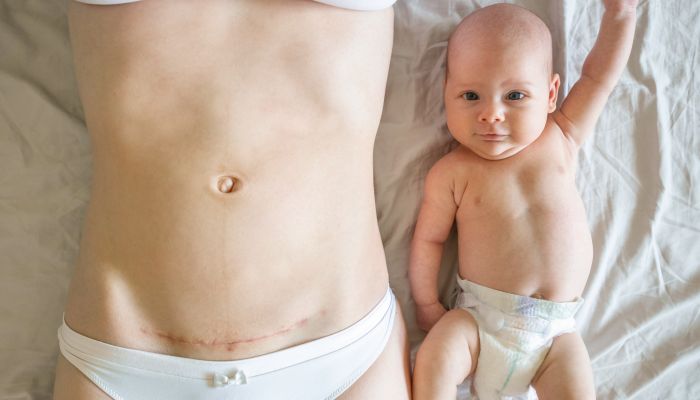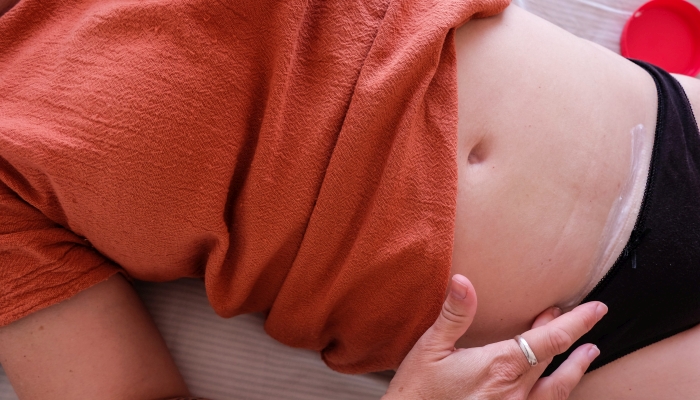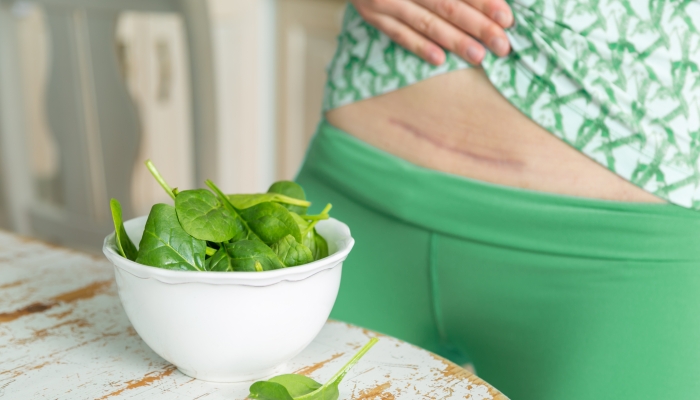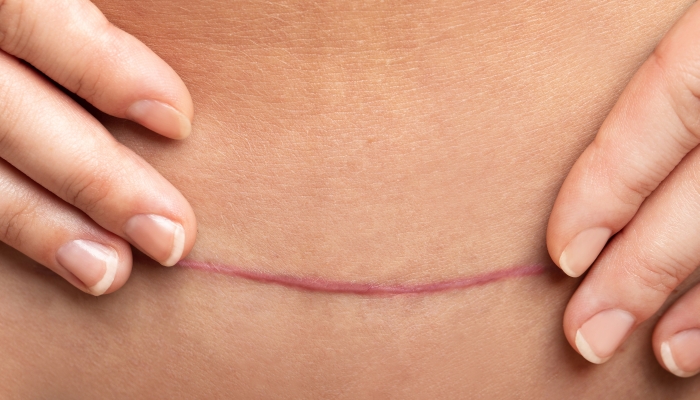C-Section Scar Healing Stages and Care

- A C-section will leave a scar that usually fades to a thin line within a year.
- C-section incisions completely close within 6-8 weeks.
- Hypertrophic scars form when there is repeated inflammation or an overproduction of collagen.
- Keloid or hypertrophic scarring can be corrected with cosmetic surgery and laser therapy.
- To minimize scarring, keep your incision clean and dry, avoid pulling at the incision site, and wear an abdominal binder.
A C-section is a surgical procedure that can bring your baby into the world safely, either when a vaginal birth is experiencing complications, or if you’ve chosen an elective C-section for other reasons. You may need a C-section if you have prolonged labor, your baby is in a difficult position, or if you have placenta previa.
Even if you would prefer a vaginal birth, it’s wise to think about having a C-section plan. About one third of babies born in the United States are delivered by C-section. This includes both emergency and scheduled C-sections.
While they are quite common and safe, C-sections are a major surgery and will leave a scar on your abdomen. With the right knowledge about C-section scar healing stages and care, you can minimize scarring and speed up the healing process.
What Are the Types of C-section Incisions?
When you get a C-section, the doctor will actually make two incisions. One through the skin, and another through the uterus. Depending on your doctor and your medical needs, your incision can be a low transverse, low vertical, or classical.
Low transverse
A low transverse cut is also called a “bikini incision” and is the most common kind of C-section incision. For this approach, the surgeon makes a horizontal incision at the very lowest part of the uterus. A transverse C-section scar runs right along the bikini line and is covered by most bikinis.
The low transverse incision is ideal because it involves the thinnest part of the uterus and has the lowest risk of bleeding. The transverse cut is also the least likely to have problems if you attempt a vaginal birth after cesarean delivery.
Low vertical
A low vertical incision is performed when your baby is positioned feet first or sideways. Your surgeon will make a vertical cut at the bottom of your uterus to deliver your baby safely. The C-section scarring left by a low vertical incision will extend up towards your belly button and may be visible when you wear a crop top or bikini.
Classical
A classical incision is the quickest way to get your baby out. This approach is used for emergencies and extremely small or preterm babies. It is a vertical incision higher up on the abdomen and uterus. The classical incision is the most likely to have complications like infection and bleeding. It will also leave the biggest, most obvious c section scar.

How Long Does It Take for a C-section Wound to Heal?
While the healing process will be different for each mother and each delivery, a major surgery like a C-section takes about 6 weeks to heal. Your doctor may use surgical glue, staples, or stitches to close your incision. Healing time is about the same no matter which type of closure technique is used.
Week 1
After a C-section, you’ll stay in the hospital for 2-4 days while you recover. The nurses and doctors will help you care for your incision until you are ready to go home, and give you pain medication for any incision pain.
For the first week of your recovery, take it easy and avoid any movements that will put pressure on your incision. This is especially important for vertical incisions, since they are more likely to re-open than horizontal incisions. Wearing an abdominal binder or supportive underwear can help support your muscles as they heal.
Week 2-5
You should have a follow up visit with your doctor about 2 weeks after your c-section delivery. At your appointment, your doctor will check the incision site and skin surrounding it for any signs of infection. Signs of infection include redness, drainage, or swelling.
During the first few weeks post surgery, avoid lifting anything heavier than your baby. Light exercise like walking is a great way to help your body heal without putting too much strain on your incision. Walking can also help you avoid blood clots, a common problem after major surgery.
Week 6 and beyond
Most moms have one last follow up appointment 6 weeks post surgery. At this appointment, your doctor will most likely give you the okay to return to your normal activities. After 6 weeks, the risk of uterine rupture or the incision opening back up is low. Remember to gradually increase your activity until you are feeling back to normal and continue to watch for signs of infection.

Stages of C-section Scar Healing
The healing process of any incision site can be broken down into three stages; the inflammatory stage, the proliferative stage, and the remodeling stage.
Inflammatory stage
During the first few days after your C-section, your body will be in the inflammatory stage. During this stage, white blood cells gather in the area to prevent infection and your incision site will be pink and swollen.
Proliferative stage
During the next few weeks, collagen and new blood vessels form at the surgical site. In the proliferative stage, your pink surgical site will fade to a lighter color and thicker scar tissue forms.
Remodeling stage
This final stage of healing can last up to a year. Your puffy scar tissue that was created in the proliferative stage will start to flatten and fade.
What Are the Types of C-section Scars?
Usually, your original incision line will fade and be fully healed in a few months. A typical scar heals and becomes nothing more than a flat mark on the skin. Occasionally, your body will overproduce collagen and hypertrophic or keloid scarring can occur.
Hypertrophic scars
A hypertrophic scar is caused by continued inflammation and overproduction of collagen. Hypertrophic scars are more likely to develop if you have repeated injury to the site. This can happen if you are twisting, bending, or lifting heavy objects before your C-section incision heals completely. A hypertrophic C-section scar may also develop if you get an infection during the healing process
Keloid scars
Keloid scars form when the skin gets stuck in the proliferative stage. Unlike a hypertrophic C-section scar, a keloid scar extends into the surrounding skin and can continue to grow for years.
There seems to be a genetic component to the development of keloid C-section scars. If you have family members with keloid scarring, you are more likely to develop them yourself. If you already have one keloid scar, your chances are higher of getting another one.
Overhang
Overhang happens when the scar tissue adheres to the abdominal wall. This causes the skin at your C-section scar to be tighter than the surrounding skin, which creates a pouch of fat or skin that hangs over the scar. A plastic surgeon can remove extra skin and help correct overhang by performing a tummy tuck.
How to Care for a C-section Incision Site
The most effective way to minimize C-section scars is to take good care of your incision site for the first few weeks. If your C-section incision opens up or gets infected, there is a good chance that your section scar will be larger and more obvious.
Infections are the most common complication following any major surgery. Make sure to wash your hands well before touching your incision site to prevent contamination. Remember that bacteria grows best in a warm, moist environment. Sweat and breastmilk can get trapped under tight fitting clothing and create a perfect environment for germs to grow. You can shower and bathe normally after a C-section, but let your C-section scar dry right away when you are done.
The second most common complication of surgery is wound dehiscence. This is the term used to describe a surgical incision that reopens. You can prevent this by avoiding heavy lifting or twisting while your incision heals.
Good lifestyle choices like eating a healthy diet and exercising also help your C-section heal and prevent major scarring.

Tips to Minimize C-section Scars
While any major surgery will result in some scarring, there are things you can do to minimize the development of scar tissue.
At home prevention
Easy things you can do at home to minimize scarring include:
- Keep your incision clean and dry
- Avoid heavy lifting in the first few weeks after surgery
- Wear loose-fitting clothing until your C-section incision heals
- Eat enough protein
- Use silicone sheets or silicone strips
- Avoid vigorous exercise right after surgery
- C-section scar massage
Medical prevention
It is important to keep your C-section incisions closed and avoid infection. Your doctor may send you home with steri strips to help your incision stay closed and clean. If you notice that your section scar is red or inflamed after two weeks, seek professional medical advice.
Steroid injections can minimize the inflammation that leads to more obvious scarring. These injections are only available by prescription through your provider.
Surgical procedures
Even with the best incision care, some people will develop a large or obvious C-section scar. If it has been a year since your abdominal incision and your scar is still raised, you can talk to a plastic surgeon about a scar revision.
Plastic surgeons are specially trained to be able to flatten scars to reduce their appearance. However, repairing a keloid C-section scar with surgery is ineffective in 90% of cases. Keloid removal usually requires both surgery and laser therapy to help your c-section scar heal correctly.
FAQs
Can a C-section scar reopen after years?
Although it is extremely rare, it is possible for a C-section scar to reopen after several years. Once an incision is made in the uterus, it is never as strong as it once was. The uterus is at risk of reopening during pregnancy and labor, especially during a vaginal birth after c-section. A C-section is more likely to reopen when mothers are overweight or have a seroma.
Is it possible to have a C-section scar infection years later?
An infection years after a C-section is another extremely rare complication. Usually, the infection develops from an abscess at the incision site and progresses to your internal organs. While this is extremely rare, it is important to understand the risk. Call your medical provider if you notice anything strange at your C-section scar, even if it has been a long time. The best treatment option for this type of infection is a hysterectomy.
Is it safe to deliver vaginally after a C-section?
A vaginal birth after C-section (VBAC) is a safe option for most mothers. Things that make you a good candidate for a VBAC include; horizontal incision, fewer than 2 previous C-sections, age under 35, and several years between C-section and attempt at a VBAC.
How soon can I get pregnant again after a C-section?
You should wait at least 6 months to get pregnant again after a C-section. Many providers recommend waiting 12-18 months, especially if you want to try a VBAC. This is because your uterus needs time to heal and strengthen before it can handle the stress of holding another baby. Becoming pregnant too soon after a C-section puts both you and your unborn baby at risk.
How will my scar change after multiple C-sections?
For many reasons, you may choose to have a repeat C-section delivery. Many mothers worry that they will be left with a second scar or one that looks worse than it did before. While there is no guarantee, most surgeons will be able to cut on the same line as before. If your scar tissue is too thick, you’ll need a new incision to bring your baby into the world safely. You may also need a new incision if you end up needing a different type of incision than you had the first time.

The information WonderBaby provides is not intended to be, and does not constitute, medical or other health advice or diagnosis and should not be used as such. Always consult with a qualified medical professional about your specific circumstances.
Related Posts

Pregnancy
How To Deal With an Ingrown Hair on a C-Section Scar
Ingrown hairs on a C-section scar can be treated using a warm compress or mild exfoliation. Infected ingrown hairs may require antibiotic treatment.

Pregnancy
What’s a Dye Stealer Pregnancy Test?
A dye stealer pregnancy test usually means that your hCG levels are very high, which is typically considered a good sign for pregnancy.

Pregnancy
Can Yelling Cause a Miscarriage?
Yelling alone can not cause a miscarriage. However, maternal stress can cause high blood pressure, preterm labor, and other health problems.